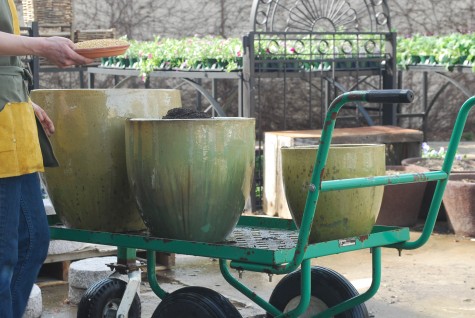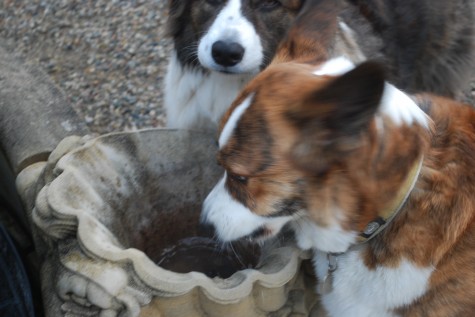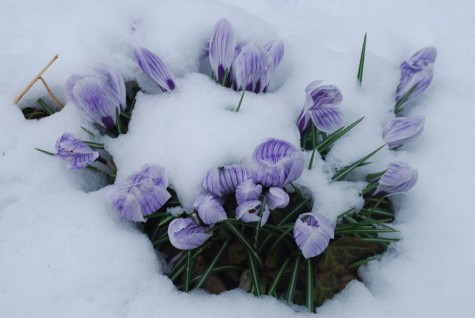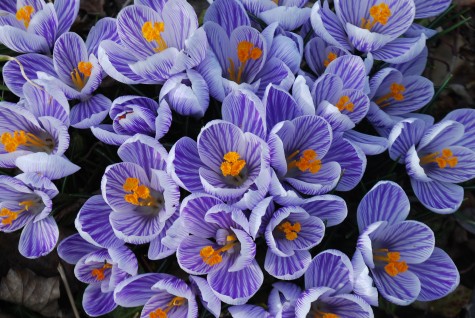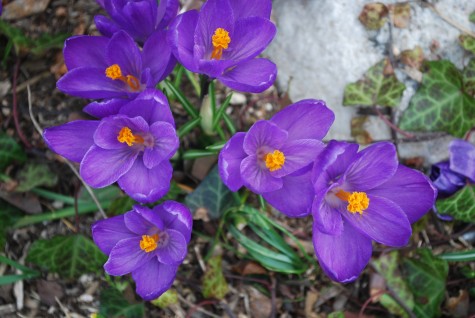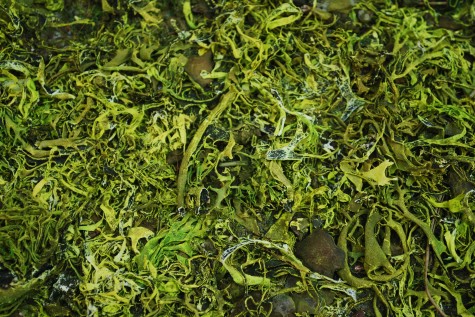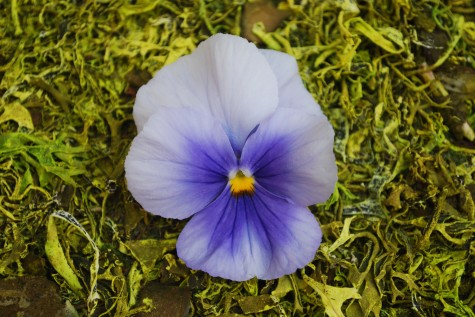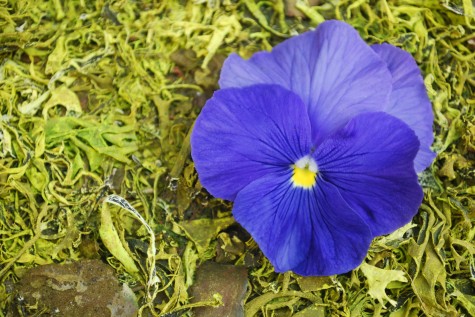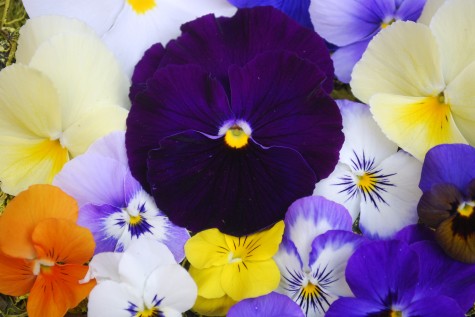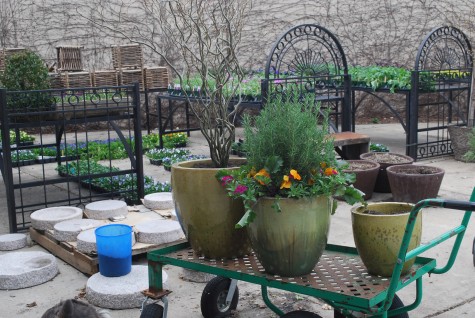 My last post dealt with how I prep a pot for planting. I am sure other people have methods that work just as well for them. As I plant lots of pots, I need a method that works well in general, and specifically in consideration that the maintenance will be handed off to someone else. When deciding what to put in a pot, I have my list of questions. Is growing plants your most favorite thing to do, after your children, or breathing? Do you have a stack of responsibilities that makes a low maintenance planting a plus? Are you watering on the fly, or do you make time to individually water plants in a given container? Do you like big bouquet plantings that look like a Dutch flower painting? Does the farm and garden look appeal-or something much more crisply contemporary? How do you like your color? I planted the middle Anamese pot first with a 1.5 gallon rosemary-in recognition of that muddy blue green color at the bottom of the pot. Some small green kale with purple veins repeat that blue/green, but are a great textural foil to the needled rosemary. Hot pink annual phlox and orange pansies make for a friendly color combination that reminds me of vegetable rows altenating with marigolds. I paid much attention to that pot’s color-what would harmonize, and what would pop, in a casual way. The loose planting is a great contrast to the simple shape of the pot. The large pot presented another challenge.
My last post dealt with how I prep a pot for planting. I am sure other people have methods that work just as well for them. As I plant lots of pots, I need a method that works well in general, and specifically in consideration that the maintenance will be handed off to someone else. When deciding what to put in a pot, I have my list of questions. Is growing plants your most favorite thing to do, after your children, or breathing? Do you have a stack of responsibilities that makes a low maintenance planting a plus? Are you watering on the fly, or do you make time to individually water plants in a given container? Do you like big bouquet plantings that look like a Dutch flower painting? Does the farm and garden look appeal-or something much more crisply contemporary? How do you like your color? I planted the middle Anamese pot first with a 1.5 gallon rosemary-in recognition of that muddy blue green color at the bottom of the pot. Some small green kale with purple veins repeat that blue/green, but are a great textural foil to the needled rosemary. Hot pink annual phlox and orange pansies make for a friendly color combination that reminds me of vegetable rows altenating with marigolds. I paid much attention to that pot’s color-what would harmonize, and what would pop, in a casual way. The loose planting is a great contrast to the simple shape of the pot. The large pot presented another challenge.
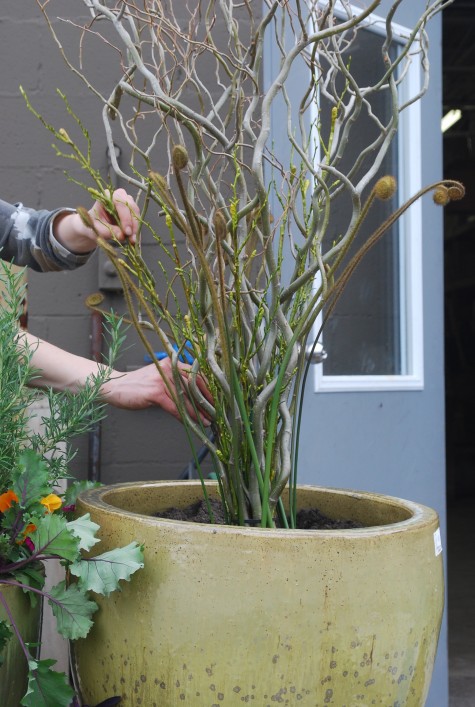 Large pots demand a planting in proportion to that size. Either the plants need to grow up into the pot, or something of scale needs doing from the beginning. Our spring season is short, and cool-not so much growing goes on. For that reason I like branches, even faux material, that will give the planting some presence from the beginning. The curly willow branches remind me of the color of the glaze; some faux fern curls and pea-green stems brighten the willow branches, and add substance and heft to the centerpiece.
Large pots demand a planting in proportion to that size. Either the plants need to grow up into the pot, or something of scale needs doing from the beginning. Our spring season is short, and cool-not so much growing goes on. For that reason I like branches, even faux material, that will give the planting some presence from the beginning. The curly willow branches remind me of the color of the glaze; some faux fern curls and pea-green stems brighten the willow branches, and add substance and heft to the centerpiece.
 The tips of the willow have the slightest suggestion of orange-as do those fern curls. I took apart an orange grass pick; some faux material can have a much better and more subtle appearance if you spread it around. Taking materials apart, and putting them back together in your own way-I invite you to do this. Using unexpected materials-why not? The yellow pansies and angelina will grow. Up close to the eye, the willow and spring plants will get your attention. From a distance, you will see a larger overall form more than the individual elements.
The tips of the willow have the slightest suggestion of orange-as do those fern curls. I took apart an orange grass pick; some faux material can have a much better and more subtle appearance if you spread it around. Taking materials apart, and putting them back together in your own way-I invite you to do this. Using unexpected materials-why not? The yellow pansies and angelina will grow. Up close to the eye, the willow and spring plants will get your attention. From a distance, you will see a larger overall form more than the individual elements.
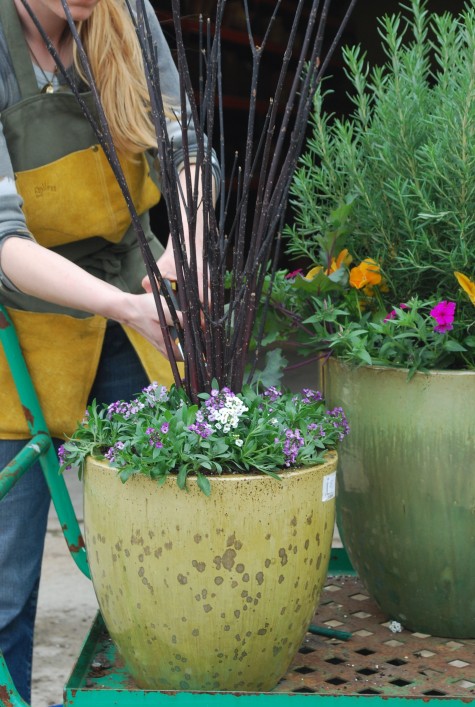 The little Anamese pot-I planted with black willow, and Easter Egg mix alyssum. A simple vertical element in contrast to a low wide mass-a simple and elegant arrangement. This small pot is planted with material that grows in proportion to the scale of the pot. As I write this, I am wondering how a large scaled plant would look in this pot; knowing the rules is what makes it possible to break them with great style.
The little Anamese pot-I planted with black willow, and Easter Egg mix alyssum. A simple vertical element in contrast to a low wide mass-a simple and elegant arrangement. This small pot is planted with material that grows in proportion to the scale of the pot. As I write this, I am wondering how a large scaled plant would look in this pot; knowing the rules is what makes it possible to break them with great style.
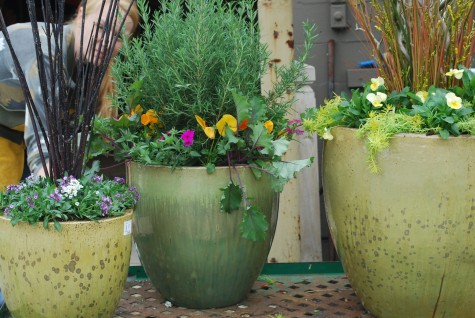 The three pots are quite different in feeling, but fairly harmonious in color. They will come on in no time, should we have night temperatures well above freezing. Once established, they will handle the Michigan spring with ease. The palette of available plants that tolerate cold may not be so great in my zone, but planting what I do have in a series of glazed pots celebrates spring in fine fashion.
The three pots are quite different in feeling, but fairly harmonious in color. They will come on in no time, should we have night temperatures well above freezing. Once established, they will handle the Michigan spring with ease. The palette of available plants that tolerate cold may not be so great in my zone, but planting what I do have in a series of glazed pots celebrates spring in fine fashion.
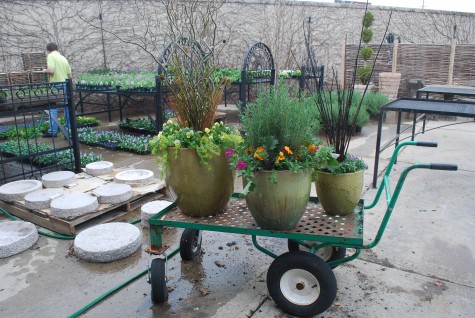
How interesting would it be to see how a group of gardeners would interpret a planting for these pots. I am sure every one would be different-based on who they are, where they garden, and what about plants move them. Pots of lovely shape and complex color would give any planting, in any zone, a big head start.
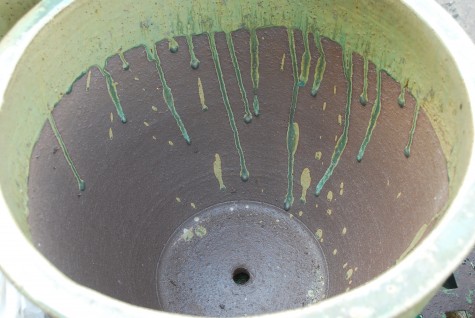
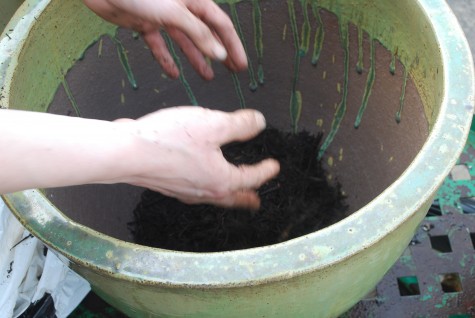
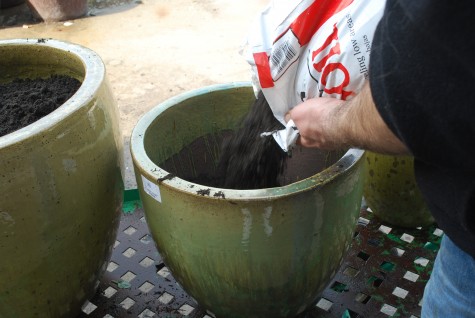 Perhaps even more important-the soil. Every gardener has a mix-I am no exception. I like a heavy soil, leavened with lots of compost and a big dollop of sand. Though plenty of garden centers sell giant bags of peat based “planting media”, I am a fan of topsoil. As in the closest thing to good garden dirt that is available.Peat based plant mixes are light-you can carry a giant bag to your car. But peat based planting media implies a professional grower on the other end who will feed that sterile soil at whatever parts per million it needs to produce good plants. My dirty little secret-good and hefty soil is essential for great plantings. A compost based soil that does not dry out too fast, that has nutrients, is perfect for garden variety gardeners. I am no fan of hauling forty pound bags of soil around-so I farm that job out to whomever I can persuade to help me. This is worth the trouble-making sure the pots get filled with great soil.
Perhaps even more important-the soil. Every gardener has a mix-I am no exception. I like a heavy soil, leavened with lots of compost and a big dollop of sand. Though plenty of garden centers sell giant bags of peat based “planting media”, I am a fan of topsoil. As in the closest thing to good garden dirt that is available.Peat based plant mixes are light-you can carry a giant bag to your car. But peat based planting media implies a professional grower on the other end who will feed that sterile soil at whatever parts per million it needs to produce good plants. My dirty little secret-good and hefty soil is essential for great plantings. A compost based soil that does not dry out too fast, that has nutrients, is perfect for garden variety gardeners. I am no fan of hauling forty pound bags of soil around-so I farm that job out to whomever I can persuade to help me. This is worth the trouble-making sure the pots get filled with great soil.

